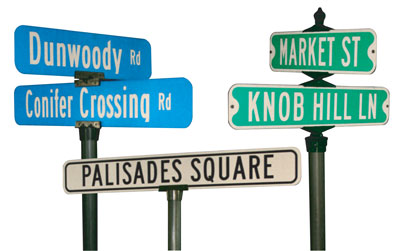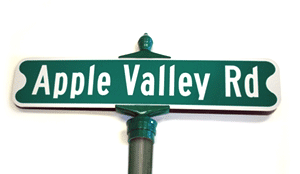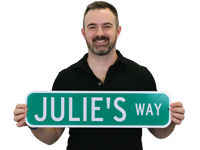
1. Do a survey of the signs. Start with a simple map and indicate where each street sign pole should go.
2. Note at each location the street sign names that you want to show. What street corners should have a street sign? Indicate if you want to show two street sign names (we call this a four-way kit) or just a single street sign name. It is most common to use 4-way sign kits.
3. Choose the style of sign that you want. We offer three different styles:
- Civic. Civic Street Signs are the Web’s most popular street sign. Printed on both sides on reflective 80 mil thick aluminum, Civic signs are the favorite of municipalities and professional street sign buyers. Buying direct from the factory saves you over 50% on these signs – they start at $27.95 each.
- Nob Hill. Need a sign that says “we are distinctive”? These sophisticated signs use double weight aluminum and traditional cast iron fittings. No sign is stronger. No sign lasts longer. Street signs start at $44.95.
- Keepsake. Keepsake signs are sold, primarily, as novelty street signs or as gift items. While heavy duty they are not reflective and are not MUTCD compliant. But, priced at just $16.95 each, Keepsake Street Signs carry a price point that makes them an ideal gift for someone special.
4. Choose the style of post that you want. There are three basic styles of posts. These are listed in order of popularity for street signs:
- Tubular Post. We like the look of these round posts best! While round or tubular posts are harder to install, they are the most common posts for street signs and give a professional look.
- U-Channel Post. These are easiest to install and also less expensive. We offer both green enamel posts and galvanized U-channel posts. The green posts are most common.
- Square Post. Square posts are used often when you want to install another sign at the same location. For example, you want to add a Stop Sign or Yield Sign to that intersection. Of course, there are brackets for the other types of posts that allow you to attach multiple signs to tubular or U-channel posts, but these add slightly to the cost.
You will also have to determine what height is best for your signs and you may need to check with the heights used by other signs in your communities. Typically, signs are 7-8’ high. For higher posts, users most often use U-Channel posts or square posts and a two-piece construction. A shorter post is installed into the ground and the longer post is attached with break-away bolts to this shorter post “stub” sticking out of the ground.
5. Do the “street sign math”. Looking at your survey, you’ll need to create a table or spreadsheet like this:
- How many posts?
- How many crossing sign locations (4-way kits)?
- How many single sign locations (2-way kits)?
- What are the Street Sign names and how many of each street sign name do you need?
Start with how many posts that you need and how many of these have two crossing street sign names (e.g. use a 4-way kit) and then how many have just a single street name (e.g. use a 2-way kit). Next, transcribe the list of street sign names from your survey. Add up the quantity that you need of each street sign name and list this quantity next to each street sign name.
6. Order Your Legends. Use our easy wizard to enter each street sign name. As you type more characters into your street sign entry field, the sign will automatically extend the width of the sign. 24” and 30” wide signs are most common.
- As part of your text entry, you may also select the font that you use for your street signs. We do not offer decorative fonts and insist that you use traditional Highway fonts or one of the newer Clearview Fonts.
- You will be able to add multiple legends at one time.
7. Determine the degree of reflectivity you need. We offer all three grades of 3M reflective film. The most common street sign material remains Engineer Grade – although, High Intensity Grade and Diamond Grade street signs are used for higher-end customers that want greater nighttime visibility and higher daytime whiteness.


Engineer grade reflective street signs are the traditional choice. High intensity reflective street signs are most popular now.
Reflective street signs are required and are an essential way for EMS, police and firefighter crews to navigate.
8. Indicate the street sign hardware that you need. You will need to specify the type and quantity of street sign posts that you need, along with the number (and type) of crossing brackets that you require. Keep your table from Step #5 (of posts and crossing pieces) handy!
 Are you about to start a street sign project? Follow these easy steps:
Are you about to start a street sign project? Follow these easy steps: 1. Do a survey of the signs. Start with a simple map and indicate where each street sign pole should go.
1. Do a survey of the signs. Start with a simple map and indicate where each street sign pole should go. 


